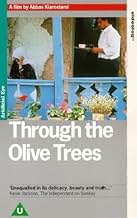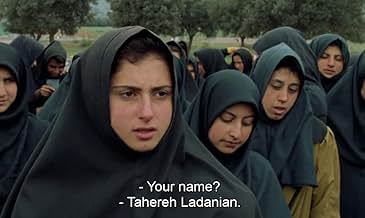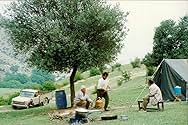AVALIAÇÃO DA IMDb
7,7/10
11 mil
SUA AVALIAÇÃO
Adicionar um enredo no seu idiomaA depiction of the off-screen relationship between the actors who play the newlyweds in the film E a Vida Continua (1992).A depiction of the off-screen relationship between the actors who play the newlyweds in the film E a Vida Continua (1992).A depiction of the off-screen relationship between the actors who play the newlyweds in the film E a Vida Continua (1992).
- Direção
- Roteirista
- Artistas
- Prêmios
- 5 vitórias e 6 indicações no total
Ostadvali Babaei
- Teacher
- (as Astadouli Babani)
Nosrat Bagheri
- Achiz
- (as Nasret Betri)
Khodabakhsh Defaei
- Teacher
- (as Kheda Barech Defai)
Hossein Jafarian
- Hossein
- (não creditado)
Jafar Panahi
- Panahi
- (não creditado)
Avaliações em destaque
Abbas Kiarostami's movies along the likes of Mr.Yasujiro Ozu and Edward yang are just like a calm stream of river that keeps on flowing eternally providing neverending relief, life and peace.
If you have enough patience and interest these movies will never bore you, and you could even watch them for many hours if their runtime was even mkre, but at last provide you with a feelgood experience as their movies are so close to our everyday reality that they feel like the stories in them could happen anywhere around us in any part of the world.
Third part of Abbas kiarostami's Koker trilogy providing behind the scenes outlook to "And life goes on...(1992)", almost feels like a complete story in itself about 2 youngsters trying hard to find eachother in all the tension surrounding, after the 1990 earthquake.
The minimalistic director Abbas kiarostami does wonders in almost his every movie that many action directors could not, a true genius.
This is the art movie in its essence. Every single minute of this movie is complexly detailed. It was considered by the critics a masterpiece but it could not be nominated for the Academy Awards in the 'Foreign Language Category' because of political problems between Iran and USA at the time (but in 99 'Children of Heaven' was nominated).
It was written by Abbas Kiarostama, who also wrote 'The White Balloon' (another great film) and 'Taste of Cherry' (not so good, although it won the Cannes Palm D'or).
This is a must see for any fan of artfilms. Simply fantastic, amazing and everything else, this movie is a 'sea of creativity'.
It was written by Abbas Kiarostama, who also wrote 'The White Balloon' (another great film) and 'Taste of Cherry' (not so good, although it won the Cannes Palm D'or).
This is a must see for any fan of artfilms. Simply fantastic, amazing and everything else, this movie is a 'sea of creativity'.
This epoch-making poem opens with a film crew trying to cast for a movie in a provincial village, in the aftermath of A DEVASTATING EARTHQUAKE which has claimed many, many lives. We then are shown that the remaining people are trying to rebuild their lives, picking up bits and pieces of the past, but with an eye to the future.example of these people are the boy and the girl who are selected to play the protagonists of the melodrama to be made. The crew's interest interest in these people is limited to their role and usefulness for director's vision of the film, and no more. But-and this is a crucial BUT-the boy and the girl have their own agenda, and don't care very much for the screenplay dictated by the director (for instance repeated takes of the tea-serving scene): The girl wants to wear colorful and jolly dress, and the boy wants to be able to love her. Eventually, the boy follws the girl into the magnificent ending shot of the expanse of the olive groves, and into the ubncertain but potentially hopeful future. Will life, love and color be able to vanquish darkness and death? Will the boy and the girl find the courage and and power to fire the crew, the director, the casting agent , down to the ticket-vendor and become subjects of their own life and destiny? ... This is to be continued.........
Through the Olive Trees is a great example of how neo-realistic techniques can show realism in film making. One personal criticism would be the music, but that is purely personal, and takes nothing away from the film. A masterpeice.
Following a film he made a few years backs, a director returns to the area where it was shot to try and find the actors who he used. The area has been hit by a large earthquake and the film is designed to help the area as well as follow up on the people. Among the cast is a young man, Hossein, who has fallen for one of the other actors and seeks to marry her but her grandmother refuses to consider any such offer; ironic perhaps, considering Hossein's character in the film is married to the very girl he loves in real life.
While making the sequel (or follow up) to "Where is the friend's house?" Abbas Kiarostami met a man who told him that he was married 5 days after the devastating earthquake (50,000 dead) that is the foundation for that film. A few years later Kiarostami decided to use this man and his story as the basis for this rather intriguing film within a film. The dual plots are interesting and work well in contrast to one another to fill out a plot that is not the easiest to get excited about or really engaged by. In this regard many viewers may feel bored or distant from the material as it doesn't quite build a story that well. The "film within a film" concept is interesting but it produces many scenes that are replayed over and over (different takes) without the repeats adding a great deal in fact they seem to take away from the rhythm of the film more than give to it. As with other Kiarostami films, it is slow and requires work, but even if you are willing to put yourself into it, it is still not easy work.
The characters and place are interesting and it does feel like these are over and above the material itself. The film will be of greater interest to those who have seen the other films in the trilogy as the places and people have history to them, but they are still well enough done to avoid it being key to the film. The cast do pretty well throughout; Rezai steals the show with a good performance; Ladanian is totally absent and her performance will be hard (was hard!) for a Western audience to appreciate. Keshavarz does pretty well in the role of the director.
Overall this is not a film to come to unless you have seen at least one of the other two films (ideally both. It is watchable without this knowledge but even with it, it is hard work at times. The narrative is slow and not that important apparently and, although the characters and places are interesting, I did struggle to really get emotionally involved in the film. Interesting enough to be worth a look but don't expect too much from it.
While making the sequel (or follow up) to "Where is the friend's house?" Abbas Kiarostami met a man who told him that he was married 5 days after the devastating earthquake (50,000 dead) that is the foundation for that film. A few years later Kiarostami decided to use this man and his story as the basis for this rather intriguing film within a film. The dual plots are interesting and work well in contrast to one another to fill out a plot that is not the easiest to get excited about or really engaged by. In this regard many viewers may feel bored or distant from the material as it doesn't quite build a story that well. The "film within a film" concept is interesting but it produces many scenes that are replayed over and over (different takes) without the repeats adding a great deal in fact they seem to take away from the rhythm of the film more than give to it. As with other Kiarostami films, it is slow and requires work, but even if you are willing to put yourself into it, it is still not easy work.
The characters and place are interesting and it does feel like these are over and above the material itself. The film will be of greater interest to those who have seen the other films in the trilogy as the places and people have history to them, but they are still well enough done to avoid it being key to the film. The cast do pretty well throughout; Rezai steals the show with a good performance; Ladanian is totally absent and her performance will be hard (was hard!) for a Western audience to appreciate. Keshavarz does pretty well in the role of the director.
Overall this is not a film to come to unless you have seen at least one of the other two films (ideally both. It is watchable without this knowledge but even with it, it is hard work at times. The narrative is slow and not that important apparently and, although the characters and places are interesting, I did struggle to really get emotionally involved in the film. Interesting enough to be worth a look but don't expect too much from it.
Você sabia?
- CuriosidadesThe first film in which Abbas Kiarostami has hired a professional actor (Mohamad Ali Keshavarz who plays the director of the film-within-the-film).
- ConexõesFeatured in Cinema Iran (2005)
Principais escolhas
Faça login para avaliar e ver a lista de recomendações personalizadas
- How long is Through the Olive Trees?Fornecido pela Alexa
Detalhes
- Data de lançamento
- Países de origem
- Central de atendimento oficial
- Idioma
- Também conhecido como
- Through the Olive Trees
- Locações de filme
- Empresas de produção
- Consulte mais créditos da empresa na IMDbPro
Bilheteria
- Faturamento bruto nos EUA e Canadá
- US$ 40.300
Contribua para esta página
Sugerir uma alteração ou adicionar conteúdo ausente

Principal brecha
By what name was Através das Oliveiras (1994) officially released in India in English?
Responda





















